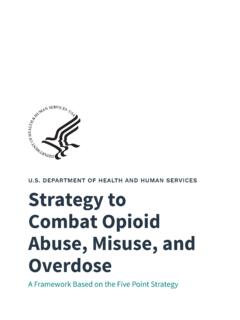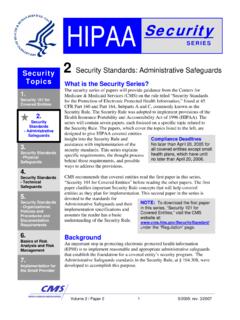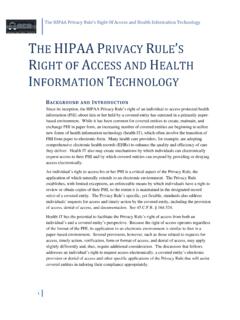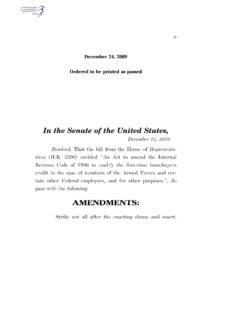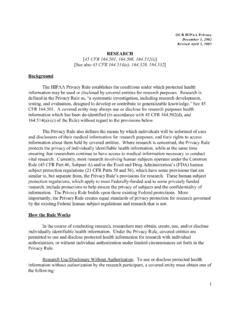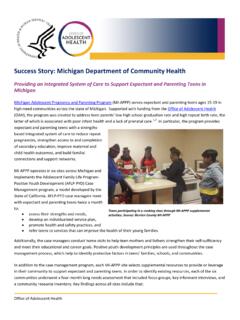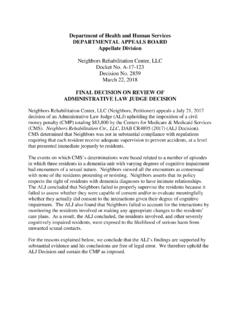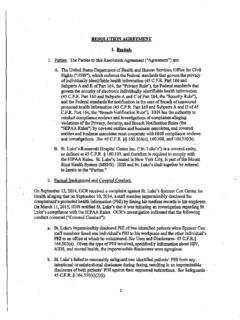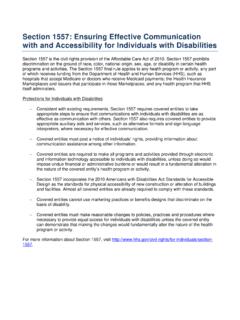Transcription of Performance Appraisal Handbook - HHS
1 Working Smarter for America Department of Health and Human Services Performance Management Appraisal Program (PMAP) Handbook A Resource Guide for Supervisors and Employees Office of the Secretary Office of Human Resources HHS PMAP Handbook TABLE OF CONTENTS INTRODUCTION .. 4 IMPORTANCE OF Performance MANAGEMENT ..5 PLANNING .. 6 Developing Performance Plans ..6 Employee Performance Plan: HHS Form Administrative Requirements Element ..8 Performance Elements ..9 Performance Benchmark Standards ..11 Employee Documenting Elements and Standards ..14 MONITORING Feedback During the Performance Midyear Review ..15 DEVELOPING EMPLOYEES ..15 Formal Employee Development ..16 Informal Employee Development ..17 RATING EMPLOYEES ..17 Roles of the Rating Official.
2 17 REWARDING Performance ..18 Performance Award Eligibility ..18 ADDRESSING POOR Partially Achieved Expected Results Achieved Unsatisfactory Results Level ..19 Unsatisfactory Performance Vs. Misconduct ..20 SUPERVISOR S CHECKLIST FOR APPRAISALS ..20 Meeting with Conducting Midyear Reviews ..21 Conducting End-of-Year Reviews ..22 EMPLOYEE S CHECKLIST FOR Advantages of a Midyear Review to the Employee ..22 Employee Preparation for the Midyear Review ..23 Employee Preparation for the End-of-Year Review ..23 Employee Discussion During the End-of-Year DEVELOPING THE INDIVIDUAL DEVELOPMENT PLAN (IDP)..24 Goals of the IDP ..24 Employee s Responsibilities for an IDP ..26 2 HHS PMAP Handbook Rating Official s Responsibilities for an QUESTIONS AND ANSWERS ..27 Awards In Performance -Based Time-Off Awards ..28 The Performance Labor Relations ..31 Quality Step Increase (QSI).
3 32 Performance Plans ..32 GUIDE FOR NON-STANDARD SITUATIONS ..35 DEFINITIONS .. 37 3 HHS PMAP Handbook INTRODUCTION Managing employee Performance is an integral part of the work that all managers and rating officials perform throughout the year. It is as important as managing financial resources and program outcomes because the degree of employee Performance has a profound effect on both the financial and programmatic components of any organization. The Performance Management Appraisal Program (PMAP) policy of the Department of Health and Human Services is designed to document the expectations for both individual and organizational Performance , provide a meaningful process by which employees can be rewarded for noteworthy contributions to the organization, and provide direction to improve organizational success at every level.
4 To accomplish these objectives, managers need to identify organizational goals to be accomplished, communicate individual and organizational goals to employees that support the overall strategic mission and the Government Performance and Results Act (GPRA) goals of the Department, monitor and evaluate employee Performance , and use Performance as a basis for appropriate personnel actions including rewarding noteworthy Performance and taking remedial action to improve Performance not meeting expectations. The Office of Personnel Management (OPM) defines Performance management as the systematic process of: Planning work and setting expectations. Continually monitoring Performance . Developing the capacity to perform . Periodically rating overall Performance . Rewarding noteworthy Performance . This HHS PMAP Handbook complements the Department s PMAP policy, dated April 6, 2015, and provides supervisors and employees with a uniform working guide for the day-to-day administration of Performance management.
5 This Handbook is intended to help supervisors manage employee Performance that is aligned with and in support of organizational goals. This Handbook includes step-by-step explanations, and easy-to-follow checklists, for activities conducted throughout the Performance cycle, and it standardizes working procedures to ensure consistent conformance to Departmental requirements. As such, this Handbook serves as a valuable training resource especially as a quick overview of Performance management requirements for supervisors and employees, including new employees. This Handbook provides information and guidance and must not be construed to contradict Departmental PMAP policy or any Collective Bargaining Agreement. Please direct all questions and concerns to the Performance Management Division, Office of the Secretary, at 4 HHS PMAP Handbook IMPORTANCE OF Performance MANAGEMENT In today's workplace , Performance improvement and the role of Performance management are increasingly popular topics.
6 Why the intense focus on Performance management now? Business pressures are ever-increasing and organizations are now required to become even more effective and efficient, execute better business strategies, and do more with less to remain competitive. The primary reason to ensure Performance management processes are functioning properly is to tighten the link between strategic business objectives and day-to-day actions. Effective goal setting (including timelines), combined with a method to track progress and identify obstacles, contribute to success and bottom-line results. Regularly tracking progress against Performance goals and objectives also provides the opportunity to recognize and reward employees for Performance and exceptional effort, contributing to job satisfaction, and productivity. What is the impact of a poorly structured and implemented Performance management process? If individual goals are not aligned with business strategy, then time and resources are wasted.
7 Low employee engagement levels may mean that individuals are not performing at their best. Inconsistent evaluation criteria and rewards can lead to mistrust, lower productivity, and higher attrition. If top performers see no differentiation in Performance ratings, no opportunities, and unfair compensation for under-performers, morale can suffer. Lack of documentation, visibility, and accountability can negatively affect stakeholders who are demanding more transparency. If accurate Performance information is unavailable, or difficult to access, training and development decisions, along with project assignment decisions, may not be made in the Department s, or in the individual's, best interests. An annual process will not adequately alert managers to problems in a timely manner. Last, but not least, a lack of proper documentation related to Performance may result in legal issues. Management "buy-in" is essential to the Performance management process. When management does not understand the importance and value of the process, the results can range from consistently late or incomplete appraisals to employee-management mistrust, avoidance of Performance discussions, and a lack of honest Performance -related discussions.
8 Additionally, managers may feel unprepared to deliver quality feedback and to oversee effective Performance discussions. Frequently, when Performance management is mentioned, people think of the employee Performance Appraisal or review. Performance management, however, involves much more. Properly constructed appraisals should represent a summary of an ongoing and year-long dialogue. An effective Performance management process enables managers to evaluate and measure individual Performance and optimize productivity by: Aligning individual employee's day-to-day job responsibilities with strategic business objectives. Providing visibility and clarifying accountability related to Performance expectations. Documenting individual Performance to support compensation and career planning decisions. Establishing focus for skill development and learning opportunities. Creating documentation for Departmental purposes to support decisions and reduce disputes. 5 HHS PMAP Handbook Many of the practices that support Performance also positively impact job satisfaction, employee retention, and engagement; as well as trust and loyalty.
9 Performance management practices include: Delivering regular relevant job feedback. Setting and communicating clear Performance expectations. Clearly linking Performance to compensation. Evaluating Performance and delivering incentives in a fair and consistent manner. Providing appropriate learning and development opportunities. Recognizing and rewarding top performers. Employees want to feel successful, to do well at their job, and feel they are making a valuable contribution. To ensure this happens, employees need a clear understanding of individual goals and how they fit into the larger organization. When effectively implemented, the best practices of Performance management result in a wide range of benefits and successes for employees, managers, and the overall organization in the following ways: Organizational Benefits of Effective Performance Management Department-wide Supervisors/Managers Employees Savings Time Savings Clarification of Expectations Retention Reduced Conflicts Improved Self-assessment Performance Visible Accountability Improved Performance Productivity Efficiency Job Satisfaction The Department is taking steps to implement innovative solutions that ensure processes deliver real results and improve Performance .
10 The purpose of this Handbook is to provide concrete guidelines and practical steps that can be used to facilitate improvements to the Department s Performance management processes. PLANNING In an effective organization, work is planned in advance. This includes setting Performance expectations and goals for individuals to channel efforts toward achieving organizational objectives. Involving employees in the planning process is essential to their understanding of the goals of the organization and expectations, what needs to be done and why for accomplishing those goals. Developing Performance Plans The regulatory requirements in 5 CFR 430 for defining an employee s Performance expectations include establishing elements and standards in an employee-specific Performance plan. The employee s Performance plan outlines the specific critical job elements for which the employee will be held individually accountable during the rating cycle and that must be successfully completed for the organization to satisfactorily carry out its mission and the standards against which the employee s Performance will be measured; , how well the employee must perform on each element to be 6 HHS PMAP Handbook appraised at a specific level.
